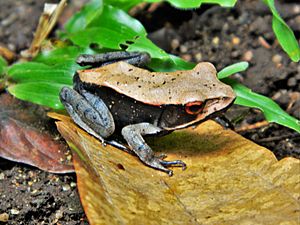Native species facts for kids

A native species is an animal, plant, or other living thing that naturally lives in a certain area or ecosystem. Its presence there is due to natural evolution over a long time. You might also hear these species called indigenous or autochthonous.
When humans bring a species to a new place where it didn't naturally live, it's called an introduced species. If this introduced species causes a lot of harm to the environment, economy, or other species, it's then called an invasive species.
It can sometimes be tricky to decide if a species is truly native. This is because Earth's conditions are always changing. Over millions of years, tectonic plates move, and the climate shifts. These changes affect where species can live. Species naturally appear, spread, or even become extinct. Their homes are rarely fixed in one spot forever.
A native species is not always an endemic species. An endemic species is found only in one specific place. A native species might live in many different areas, not just the one you are thinking about. Also, being native or endemic doesn't mean the species first appeared or evolved in that exact spot.
Contents
How Native Species Fit into Nature

Native species live together in communities. They have special connections with other plants, animals, fungi, and tiny organisms. For example, some plants need a specific animal to pollinate their flowers so they can make seeds. That pollinating animal might also depend on that plant for food.
Many species have learned to live in very specific or tough conditions. This could be a cold climate or places with frequent wildfires. Other species can live in many different kinds of places and adapt easily to new surroundings.
How Humans Affect Native Species
Different parts of the world have unique species because natural barriers separate them. These barriers include large rivers, seas, oceans, mountains, and deserts. Humans have started moving species across the globe faster than ever before. This means species that have never met in their evolutionary history are now coming into contact.
When humans bring species to new places, sometimes on purpose for farming, or by accident, some of these species can become invasive. Invasive species can greatly harm native communities. They can change how an ecosystem works, how many species live there, and what kinds of species are present. Besides harming nature, these species can also damage farms, buildings, and important cultural sites. Many groups and governments are now working hard to stop invasive species.
Protecting Native Species
Many groups work to protect native plants and animals. Organizations like the Society for Ecological Restoration and various native plant societies encourage people to use native plants in their gardens. They also help identify natural areas that still have their original native species.
Many books have been written about planting native plants in home gardens. There is some debate among native plant supporters about using plant types that are grown from native species but have been changed by humans (called cultivars).
Why Native Species are Important for Conservation
When people try to restore a natural area that has been damaged, it's very important to use the correct native species. If they don't, the restored area might not truly be like the original ecosystem. For example, in 1975, workers tried to stop sand dunes from eroding at the Los Angeles International Airport. They planted a mix of seeds. But the seeds were from plants that didn't naturally grow in that specific dune area.
This mistake harmed the El Segundo blue butterfly. This butterfly is an endangered species. It depends on a specific native plant called the dune buckwheat (Eriogonum parvifolium) for its survival. The wrong plants took over the butterfly's habitat. When the invasive plants were removed, the dune buckwheat could grow back. This helped the El Segundo blue butterfly population start to recover.
See also
 In Spanish: Especie nativa para niños
In Spanish: Especie nativa para niños

